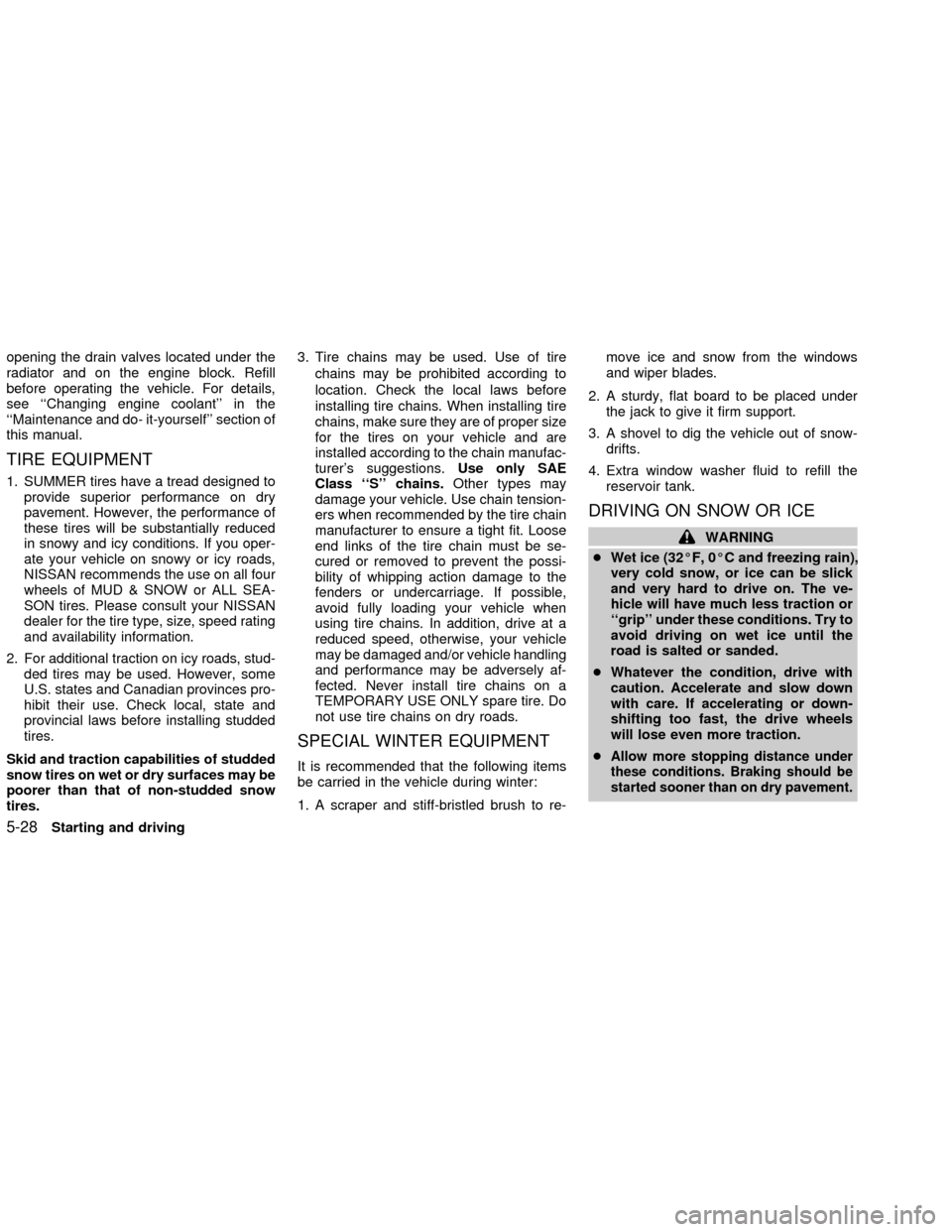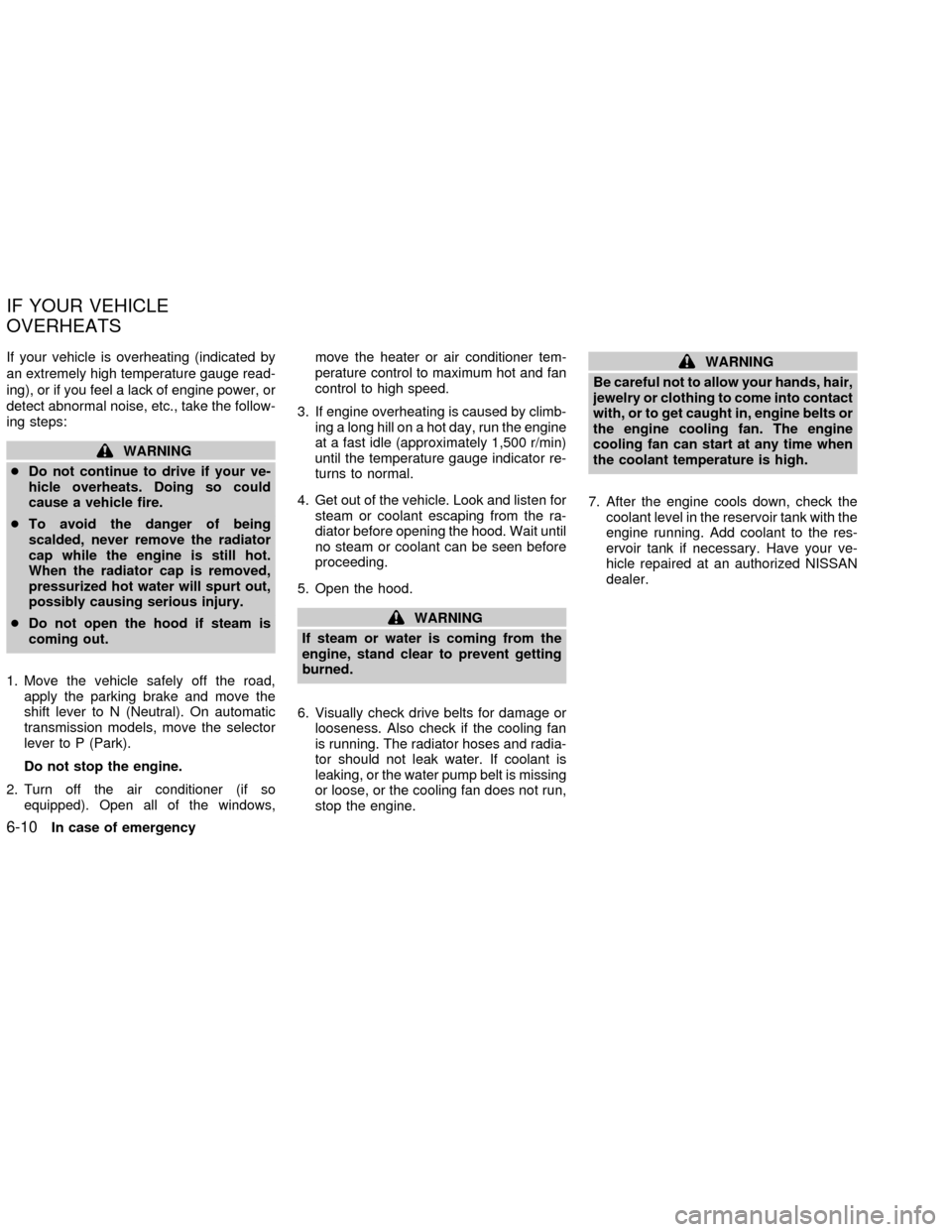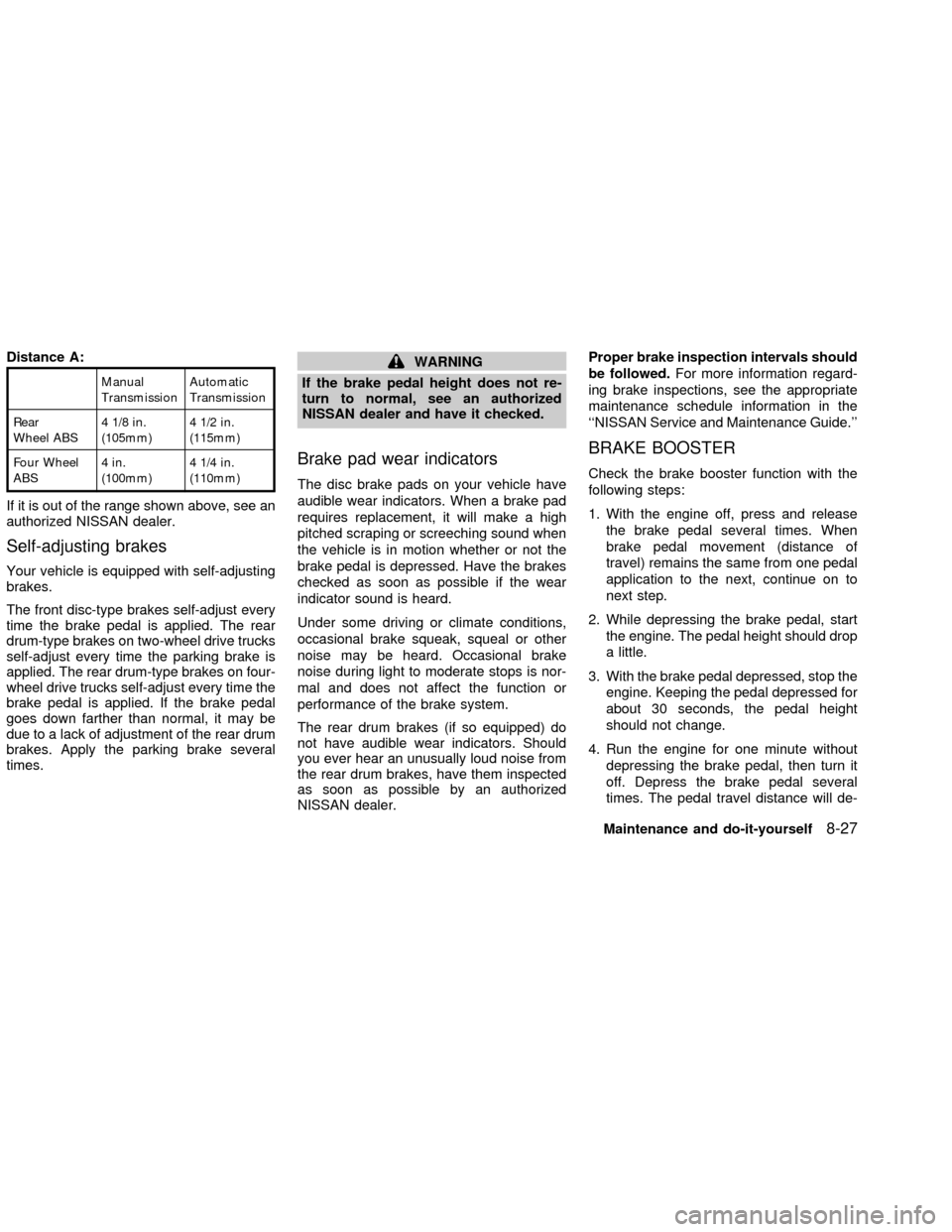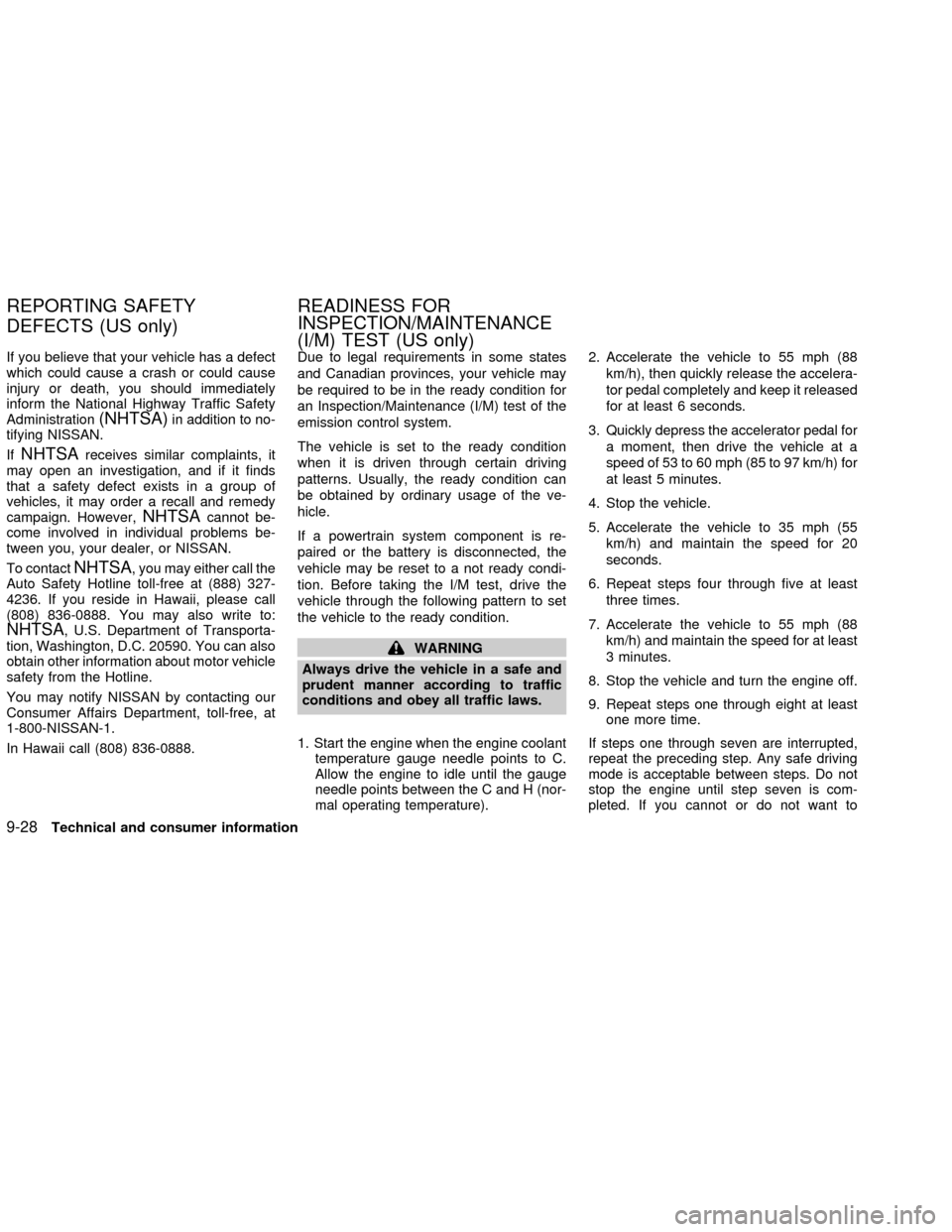2002 NISSAN FRONTIER stop start
[x] Cancel search: stop startPage 165 of 273

opening the drain valves located under the
radiator and on the engine block. Refill
before operating the vehicle. For details,
see ``Changing engine coolant'' in the
``Maintenance and do- it-yourself'' section of
this manual.
TIRE EQUIPMENT
1. SUMMER tires have a tread designed to
provide superior performance on dry
pavement. However, the performance of
these tires will be substantially reduced
in snowy and icy conditions. If you oper-
ate your vehicle on snowy or icy roads,
NISSAN recommends the use on all four
wheels of MUD & SNOW or ALL SEA-
SON tires. Please consult your NISSAN
dealer for the tire type, size, speed rating
and availability information.
2. For additional traction on icy roads, stud-
ded tires may be used. However, some
U.S. states and Canadian provinces pro-
hibit their use. Check local, state and
provincial laws before installing studded
tires.
Skid and traction capabilities of studded
snow tires on wet or dry surfaces may be
poorer than that of non-studded snow
tires.3. Tire chains may be used. Use of tire
chains may be prohibited according to
location. Check the local laws before
installing tire chains. When installing tire
chains, make sure they are of proper size
for the tires on your vehicle and are
installed according to the chain manufac-
turer's suggestions.Use only SAE
Class ``S'' chains.Other types may
damage your vehicle. Use chain tension-
ers when recommended by the tire chain
manufacturer to ensure a tight fit. Loose
end links of the tire chain must be se-
cured or removed to prevent the possi-
bility of whipping action damage to the
fenders or undercarriage. If possible,
avoid fully loading your vehicle when
using tire chains. In addition, drive at a
reduced speed, otherwise, your vehicle
may be damaged and/or vehicle handling
and performance may be adversely af-
fected. Never install tire chains on a
TEMPORARY USE ONLY spare tire. Do
not use tire chains on dry roads.
SPECIAL WINTER EQUIPMENT
It is recommended that the following items
be carried in the vehicle during winter:
1. A scraper and stiff-bristled brush to re-move ice and snow from the windows
and wiper blades.
2. A sturdy, flat board to be placed under
the jack to give it firm support.
3. A shovel to dig the vehicle out of snow-
drifts.
4. Extra window washer fluid to refill the
reservoir tank.
DRIVING ON SNOW OR ICE
WARNING
cWet ice (32ÉF, 0ÉC and freezing rain),
very cold snow, or ice can be slick
and very hard to drive on. The ve-
hicle will have much less traction or
``grip'' under these conditions. Try to
avoid driving on wet ice until the
road is salted or sanded.
cWhatever the condition, drive with
caution. Accelerate and slow down
with care. If accelerating or down-
shifting too fast, the drive wheels
will lose even more traction.
c
Allow more stopping distance under
these conditions. Braking should be
started sooner than on dry pavement.
5-28Starting and driving
ZX
Page 177 of 273

If your vehicle is overheating (indicated by
an extremely high temperature gauge read-
ing), or if you feel a lack of engine power, or
detect abnormal noise, etc., take the follow-
ing steps:
WARNING
cDo not continue to drive if your ve-
hicle overheats. Doing so could
cause a vehicle fire.
cTo avoid the danger of being
scalded, never remove the radiator
cap while the engine is still hot.
When the radiator cap is removed,
pressurized hot water will spurt out,
possibly causing serious injury.
cDo not open the hood if steam is
coming out.
1. Move the vehicle safely off the road,
apply the parking brake and move the
shift lever to N (Neutral). On automatic
transmission models, move the selector
lever to P (Park).
Do not stop the engine.
2.
Turn off the air conditioner (if so
equipped). Open all of the windows,move the heater or air conditioner tem-
perature control to maximum hot and fan
control to high speed.
3. If engine overheating is caused by climb-
ing a long hill on a hot day, run the engine
at a fast idle (approximately 1,500 r/min)
until the temperature gauge indicator re-
turns to normal.
4. Get out of the vehicle. Look and listen for
steam or coolant escaping from the ra-
diator before opening the hood. Wait until
no steam or coolant can be seen before
proceeding.
5. Open the hood.
WARNING
If steam or water is coming from the
engine, stand clear to prevent getting
burned.
6. Visually check drive belts for damage or
looseness. Also check if the cooling fan
is running. The radiator hoses and radia-
tor should not leak water. If coolant is
leaking, or the water pump belt is missing
or loose, or the cooling fan does not run,
stop the engine.
WARNING
Be careful not to allow your hands, hair,
jewelry or clothing to come into contact
with, or to get caught in, engine belts or
the engine cooling fan. The engine
cooling fan can start at any time when
the coolant temperature is high.
7. After the engine cools down, check the
coolant level in the reservoir tank with the
engine running. Add coolant to the res-
ervoir tank if necessary. Have your ve-
hicle repaired at an authorized NISSAN
dealer.
IF YOUR VEHICLE
OVERHEATS
6-10In case of emergency
ZX
Page 216 of 273

Distance A:
Manual
TransmissionAutomatic
Transmission
Rear
Wheel ABS4 1/8 in.
(105mm)4 1/2 in.
(115mm)
Four Wheel
ABS4 in.
(100mm)4 1/4 in.
(110mm)
If it is out of the range shown above, see an
authorized NISSAN dealer.
Self-adjusting brakes
Your vehicle is equipped with self-adjusting
brakes.
The front disc-type brakes self-adjust every
time the brake pedal is applied. The rear
drum-type brakes on two-wheel drive trucks
self-adjust every time the parking brake is
applied. The rear drum-type brakes on four-
wheel drive trucks self-adjust every time the
brake pedal is applied. If the brake pedal
goes down farther than normal, it may be
due to a lack of adjustment of the rear drum
brakes. Apply the parking brake several
times.
WARNING
If the brake pedal height does not re-
turn to normal, see an authorized
NISSAN dealer and have it checked.
Brake pad wear indicators
The disc brake pads on your vehicle have
audible wear indicators. When a brake pad
requires replacement, it will make a high
pitched scraping or screeching sound when
the vehicle is in motion whether or not the
brake pedal is depressed. Have the brakes
checked as soon as possible if the wear
indicator sound is heard.
Under some driving or climate conditions,
occasional brake squeak, squeal or other
noise may be heard. Occasional brake
noise during light to moderate stops is nor-
mal and does not affect the function or
performance of the brake system.
The rear drum brakes (if so equipped) do
not have audible wear indicators. Should
you ever hear an unusually loud noise from
the rear drum brakes, have them inspected
as soon as possible by an authorized
NISSAN dealer.Proper brake inspection intervals should
be followed.For more information regard-
ing brake inspections, see the appropriate
maintenance schedule information in the
``NISSAN Service and Maintenance Guide.''
BRAKE BOOSTER
Check the brake booster function with the
following steps:
1. With the engine off, press and release
the brake pedal several times. When
brake pedal movement (distance of
travel) remains the same from one pedal
application to the next, continue on to
next step.
2. While depressing the brake pedal, start
the engine. The pedal height should drop
a little.
3. With the brake pedal depressed, stop the
engine. Keeping the pedal depressed for
about 30 seconds, the pedal height
should not change.
4. Run the engine for one minute without
depressing the brake pedal, then turn it
off. Depress the brake pedal several
times. The pedal travel distance will de-
Maintenance and do-it-yourself
8-27
ZX
Page 258 of 273

trailer is hitched. Do not drive the vehicle
if it has an abnormal nose-up or nose-
down condition; check for improper
tongue load, overload, worn suspension
or other possible causes of either con-
dition.
cAlways secure items in the trailer to
prevent load shift while driving.
cBe certain your outside mirrors conform
to all federal, state or local regulations. If
not, install any mirrors required for tow-
ing before driving the vehicle.
Trailer towing tips
In order to gain skill and an understanding
of the vehicle's behavior, you should prac-
tice turning, stopping and backing up in an
area which is free from traffic. Steering,
stability and braking performance will be
somewhat different than under normal driv-
ing conditions.
cAlways secure items in the trailer to
prevent load shift while driving.
c
Avoid abrupt starts, acceleration or
stops.
cAvoid sharp turns or lane changes.cAlways drive your vehicle at a moderate
speed.
cAlways block the wheels on both vehicle
and trailer when parking. Parking on a
slope is not recommended; however, if
you must do so, and if your vehicle is
equipped with automatic transmission,
first block the wheels and apply the
parking brake, and then move the trans-
mission shift selector lever into the P
(Park) position. If you move the shift
lever to the P (Park) position before
blocking the wheels and applying the
parking brake, transmission damage
could occur.
cWhen going down a hill, shift into a lower
gear and use the engine braking effect.
When ascending a long grade, down-
shift the transmission to a lower gear
and reduce speed to reduce chances of
engine overloading and/or overheating.
However, for long steep grades, do not
stay in 1st or 2nd gear when driving
above 35 MPH (56 km/h).
cIf the engine coolant rises to an ex-
tremely high temperature when the air
conditioning system is on, turn off the air
conditioner. Coolant heat can be addi-tionally vented by opening the windows,
switching the fan control to high and
setting the temperature control to the
HOT position.
cTrailer towing requires more fuel than
normal circumstances.
cAvoid towing a trailer for your vehicle's
first 500 miles (805 km).
cHave your vehicle serviced more often
than at intervals specified in the recom-
mended Maintenance Schedule.
cWhen making a turn, your trailer wheels
will be closer to the inside of the turn
than your vehicle wheels. To compen-
sate for this, make a larger than normal
turning radius during the turn.
cCrosswinds and rough roads adversely
affect vehicle/trailer handling, possibly
causing vehicle sway. When being
passed by larger vehicles, be prepared
for possible changes in crosswinds that
could affect vehicle handling. If swaying
does occur, firmly grip the steering
wheel, steer straight ahead, and imme-
diately (but gradually) reduce vehicle
speed. This combination helps to stabi-
lize the vehicle. Never increase speed.
Technical and consumer information
9-25
ZX
Page 261 of 273

If you believe that your vehicle has a defect
which could cause a crash or could cause
injury or death, you should immediately
inform the National Highway Traffic Safety
Administration
(NHTSA)in addition to no-
tifying NISSAN.
If
NHTSAreceives similar complaints, it
may open an investigation, and if it finds
that a safety defect exists in a group of
vehicles, it may order a recall and remedy
campaign. However,
NHTSAcannot be-
come involved in individual problems be-
tween you, your dealer, or NISSAN.
To contact
NHTSA, you may either call the
Auto Safety Hotline toll-free at (888) 327-
4236. If you reside in Hawaii, please call
(808) 836-0888. You may also write to:
NHTSA, U.S. Department of Transporta-
tion, Washington, D.C. 20590. You can also
obtain other information about motor vehicle
safety from the Hotline.
You may notify NISSAN by contacting our
Consumer Affairs Department, toll-free, at
1-800-NISSAN-1.
In Hawaii call (808) 836-0888.Due to legal requirements in some states
and Canadian provinces, your vehicle may
be required to be in the ready condition for
an Inspection/Maintenance (I/M) test of the
emission control system.
The vehicle is set to the ready condition
when it is driven through certain driving
patterns. Usually, the ready condition can
be obtained by ordinary usage of the ve-
hicle.
If a powertrain system component is re-
paired or the battery is disconnected, the
vehicle may be reset to a not ready condi-
tion. Before taking the I/M test, drive the
vehicle through the following pattern to set
the vehicle to the ready condition.
WARNING
Always drive the vehicle in a safe and
prudent manner according to traffic
conditions and obey all traffic laws.
1. Start the engine when the engine coolant
temperature gauge needle points to C.
Allow the engine to idle until the gauge
needle points between the C and H (nor-
mal operating temperature).2. Accelerate the vehicle to 55 mph (88
km/h), then quickly release the accelera-
tor pedal completely and keep it released
for at least 6 seconds.
3. Quickly depress the accelerator pedal for
a moment, then drive the vehicle at a
speed of 53 to 60 mph (85 to 97 km/h) for
at least 5 minutes.
4. Stop the vehicle.
5. Accelerate the vehicle to 35 mph (55
km/h) and maintain the speed for 20
seconds.
6. Repeat steps four through five at least
three times.
7. Accelerate the vehicle to 55 mph (88
km/h) and maintain the speed for at least
3 minutes.
8. Stop the vehicle and turn the engine off.
9. Repeat steps one through eight at least
one more time.
If steps one through seven are interrupted,
repeat the preceding step. Any safe driving
mode is acceptable between steps. Do not
stop the engine until step seven is com-
pleted. If you cannot or do not want to
REPORTING SAFETY
DEFECTS (US only)READINESS FOR
INSPECTION/MAINTENANCE
(I/M) TEST (US only)
9-28Technical and consumer information
ZX
Page 266 of 273

10 Index
A
Air bag
Passenger supplemental air bag
ON/OFF switch and light ...................... 1-13
Air bag (See supplemental restraint
system) ...................................................... 1-10
Air bag warning light .................................. 1-16
Air cleaner housing filter ............................ 8-23
Air conditioner
Air conditioner specification label ......... 9-14
Air conditioner system refrigerant and
lubrication recommendations.................. 9-8
Alarm system (See vehicle security
system) ...................................................... 2-15
Anchor point locations ............................... 1-36
Antenna...................................................... 4-31
Anti-lock brake system (ABS).................... 5-26
Anti-lock brake system, rear (R-ABS) ....... 5-26
Anti-lock brake warning light ..................... 2-11
Ashtray (See cigarette lighter and
ashtray) ...................................................... 2-24
Audio system
FM-AM radio with cassette player and
compact disc (CD) player ..................... 4-13
FM-AM radio with compact disc (CD)
changer ................................................. 4-18
Steering wheel audio control switch ..... 4-31
Auto-lock free-running hubs ...................... 5-21Automatic
Automatic power window switch .......... 2-29
Automatic transmission fluid (ATF) ...... 8-15
Driving with automatic transmission ....... 5-9
Transmission selector lever lock
release .................................................. 5-12
B
Battery........................................................ 8-18
Battery replacement (See remote keyless
entry system) ............................................... 3-7
Before starting the engine ........................... 5-8
Belts (See drive belts) ............................... 8-20
Brake
Anti-lock brake system (ABS) .............. 5-26
Anti-lock brake system, rear (R-ABS) .. 5-26
Brake booster ....................................... 8-27
Brake fluid ..................................... 8-17, 9-3
Brake light (See stop light) ................... 8-35
Brake pedal .......................................... 8-26
Brake system ........................................ 5-25
Brake warning light ............................... 2-11
Brake wear indicators ................. 2-15, 8-27
Parking brake check ............................. 8-26
Parking brake operation ....................... 5-16
Break-in schedule ...................................... 5-19
Bulb check/instrument panel ..................... 2-10Bulb replacement ....................................... 8-35
C
Capacities and recommended fuel/
lubricants...................................................... 9-2
Car phone or CB radio .............................. 4-32
Cargo (See vehicle loading information) ... 9-15
Check engine indicator light
(See malfunction indicator light) ................ 2-14
Child restraint with top tether strap ........... 1-36
Child restraints ........................................... 1-27
Cigarette lighter and ashtray
(accessory) ................................................ 2-24
Cleaning exterior and interior ...................... 7-2
Clutch
Clutch fluid ............................................ 8-17
Clutch pedal.......................................... 8-28
Cold weather driving .................................. 5-27
Controls
Audio controls (steering wheel) ............ 4-31
Coolant
Capacities and recommended fuel/
lubricants ................................................ 9-2
Changing engine coolant...................... 8-11
Checking engine coolant level ............. 8-10
Engine coolant temperature gauge ........ 2-5
Corrosion protection .................................... 7-5
ZX
Page 268 of 273

Hubs
Auto-lock free-running hubs ................. 5-21
I
Indicator lights and audible reminders
(See warning/indicator lights and audible
reminders) .................................................. 2-10
Inside mirror ............................................... 3-13
Instrument brightness control .................... 2-20
J
Jump seat .................................................... 1-5
Jump starting ............................................... 6-8
K
Key ............................................................... 3-2
Keyless entry system (See remote keyless
entry system) ............................................... 3-4
L
Labels
Air conditioner specification label ......... 9-14
Emission control information label........ 9-14
Engine serial number ........................... 9-13
F.M.V.S.S. certification label ................ 9-13Vehicle identification number (VIN)
plate ...................................................... 9-12
Warning labels (for SRS) ..................... 1-16
Light
Air bag warning light............................. 1-16
Brake light (See stop light) ................... 8-35
Bulb check/instrument panel ................ 2-10
Bulb replacement.................................. 8-35
Headlight aiming adjustment ................ 8-32
Headlight and turn signal switch .......... 2-20
Headlights ............................................. 8-31
Light bulbs ............................................ 8-31
Passenger supplemental air bag
ON/OFF switch and light ...................... 1-13
Spotlights (See map light) .................... 2-33
Warning/indicator lights and audible
reminders .............................................. 2-10
Lock
Door locks............................................... 3-2
Power door locks .................................... 3-3
Luggage rack (see roof rack) ...................... 3-9
Luggage (See vehicle loading
information) ................................................ 9-15
M
Maintenance
General maintenance ............................. 8-3
Inside the vehicle.................................... 8-3
Maintenance precautions ....................... 8-5
Outside the vehicle ................................. 8-3Seat belt maintenance.......................... 1-26
Under the hood and vehicle ................... 8-4
Malfunction indicator lamp (MIL) ............... 2-14
Manual windows ........................................ 2-29
Map lights .................................................. 2-33
Meters and gauges ...................................... 2-2
Mirror
Inside mirror.......................................... 3-13
Outside mirror control ........................... 3-14
Outside mirrors ..................................... 3-13
Vanity mirror ......................................... 3-13
Multi-remote control system (See remote
keyless entry system) .................................. 3-4
O
Octane rating (See fuel octane rating) ........ 9-5
Odometer ..................................................... 2-3
Oil
Capacities and recommended fuel/
lubricants ................................................ 9-2
Changing engine oil.............................. 8-13
Changing engine oil filter...................... 8-14
Checking engine oil level ..................... 8-11
Engine oil .............................................. 8-11
Engine oil and oil filter
recommendation ..................................... 9-6
Engine oil viscosity ................................. 9-7
Outside mirror control ................................ 3-14
Outside mirrors .......................................... 3-13
Overdrive switch ............................... 5-13, 5-14
10-3
ZX
Page 269 of 273

Overheat
If your vehicle overheats ...................... 6-10
Owner's manual order form ....................... 9-30
P
Parking
Parking brake check ............................. 8-26
Parking brake operation ....................... 5-16
Parking/parking on hills ........................ 5-24
Passenger supplemental air bag ON/OFF
switch and light
Passenger supplemental air bag
ON/OFF switch and light ...................... 1-13
Power
Power door locks .................................... 3-3
Power steering fluid .............................. 8-17
Power steering system ......................... 5-25
Power windows..................................... 2-27
Precautions
Maintenance precautions ....................... 8-5
On-pavement and off-road driving
precautions ............................................. 5-3
Precautions on seat belt usage............ 1-18
Precautions when starting and driving ... 5-2
Push starting ................................................ 6-9
R
Radio
Car phone or CB radio ......................... 4-32FM-AM radio with cassette player and
compact disc (CD) player ..................... 4-13
FM-AM radio with compact disc (CD)
changer ................................................. 4-18
Steering wheel audio control switch ..... 4-31
Readiness for inspection maintenance
(I/M) test..................................................... 9-28
Rear sliding window................................... 2-29
Rear window defogger switch ................... 2-19
Registering your vehicle in another
country ....................................................... 9-12
Remote keyless entry system .................... 3-4
Reporting safety defects (USA) ................. 9-28
Roof rack (see luggage rack) ...................... 3-9
S
Safety
Reporting safety defects (USA) ............ 9-28
Seat
Jump seat ............................................... 1-5
Seat belt
Precautions on seat belt usage............ 1-18
Seat belt extenders .............................. 1-26
Seat belt maintenance.......................... 1-26
Seat belts.............................................. 1-18
Three-point type with retractor ............. 1-21
Two-point type without retractor ........... 1-24
Seat belt warning light ............................... 2-13
Seats
Adjustment .............................................. 1-2
Separate seats ....................................... 1-2Service manual order form ........................ 9-30
Shifting
Automatic transmission ........................ 5-10
Manual transmission............................. 5-15
Spark plug replacement............................. 8-21
Speedometer ............................................... 2-3
Spotlights (See map light) ......................... 2-33
SRS warning label ..................................... 1-16
Starting
Before starting the engine ...................... 5-8
Jump starting .......................................... 6-8
Precautions when starting and driving ... 5-2
Push starting........................................... 6-9
Starting the engine ................................. 5-8
Steering
Power steering fluid .............................. 8-17
Power steering system ......................... 5-25
Tilting steering wheel............................ 3-12
Steering wheel audio control switch .......... 4-31
Step rail...................................................... 3-11
Stop light .................................................... 8-35
Sun shade.................................................. 2-31
Sunroof ...................................................... 2-30
Supplemental restraint system
(Supplemental air bag system).................... 1-6
Switch
Automatic power window switch .......... 2-29
Hazard warning flasher switch ............. 2-22
Headlight and turn signal switch .......... 2-20
Overdrive switch.......................... 5-13, 5-14
Passenger supplemental air bag
ON/OFF switch and light ...................... 1-13
10-4
ZX